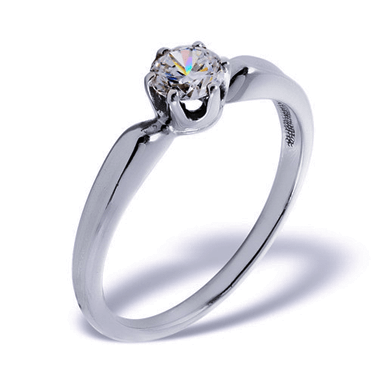Makeup of Common Metal Jewelry
Picking out a piece of jewelry could be more difficult if you don’t know a lot about the history and science around different types of metals people use to make jewelry. It’s helpful to know which metals are the hardest to damage or scratch, as well as which may cause a skin reaction when wearing it. Explore the metals jewelry makers use that are both attractive and highly durable.
Platinum
This type of metal is well revered, and expensive due to its rarity and durability. Many jewelry makers use it for quality pieces, like wedding bands. You can combine platinum with an abundance of different metals, like cobalt or copper, to increase its ability to withstand pressure, and provide a more visually appealing look.
For years, platinum was commonly used to create jewelry items until the military removed it from the jewelry market under new regulations during World War I. It returned to the market in the 1990s as a popular and in-demand metal for jewelry. To ensure it’s genuine platinum, people test for a 90% purity level. All platinum metals that pass this test receive a hallmark stamp labeled “PLAT” placed on the inside or back of the ring.
Though it’s fairly rare, it’s possible to get dermatitis if you wear a platinum ring. It may trigger any allergies or skin reactions you have, forming what’s known as a wedding ring rash. This usually occurs when you wear your ring for too long. Leaving soap and water underneath your ring after washing your hands can also cause a rash to form on your finger.
Gold
You won’t likely find pure gold jewelry since this metal is malleable and doesn’t work well for functional pieces. People usually mix gold with other non-gold metals, like nickel, silver, zinc, or copper, to create long-lasting jewelry in different colors. Karats, or carats, measure the gold content, with pure gold being 24 karats. Most jewelry you see is 14 karats, though expensive pieces contain 18 karats. There are several variations and colors of gold jewelry you can wear, including:
- Green gold: This gold contains a mixture of gold, silver, and zinc.
- White gold: In this mixture, you’ll find pure gold with white metals, including silver, palladium, and nickel, which produces a gray color. Jewelry makers plate this base mixture with rhodium to give it the white tint.
- Rose gold: A large amount of copper goes into pure gold to create this pink-tinted gold.
- Yellow gold: This classic gold combines pure gold with copper and silver.
Many people get skin allergies from gold that can cause rashes. The allergies don’t often come from the gold itself, but rather from other metals combined with the gold. A few people do experience real allergic reactions from the gold itself, though. Nickel and gold together often trigger many people’s skin allergies. Symptoms of this include rashes, itching, peeling, swelling, or blisters.
Silver

You’ll find silver, especially sterling silver, used in a wide variety of jewelry pieces like bracelets, belt buckles, rings, earrings, cuff links, and necklaces. It’s a fairly soft metal that can easily tarnish over time if you don’t properly take of it. Sterling silver is a mixture of around 92% pure silver and 7.5% copper, making it a more durable metal than silver alone. Some sterling silver is mixed with other metals instead of copper, like nickel.
Sterling silver is available in a wide range of colors and varieties. It can sport a gray-white or bright white color, or you may see it plated with gold for a more intense look. It’s also common for jewelry makers to plate other base metals with silver. Argentium sterling silver contains germanium, copper, and silver, and is tarnish-resistant, which makes it a popular option among buyers.
Silver itself is a hypoallergenic metal that can’t cause a skin reaction. If you get an allergic reaction from sterling silver, it’s from the combination of metals. For example, silver and nickel may cause a reaction, while copper is hypoallergenic and won’t cause rashes.
Titanium
Titanium is the hardest and highest-quality metal, making it very tough to scratch or damage. Combined with the fact that it’s lightweight and hypoallergenic, this metal is ideal for several jewelry items, especially body piercing pieces, like earrings. You can’t resize or solder titanium, so you probably won’t find many rings made with this metal. Your fingers can change sizes, which can cause titanium rings to get stuck. But, since it’s hypoallergenic and doesn’t need to be mixed with other metals, you don’t need to worry about allergic reactions.
Zinc
This is an affordable and more common metal that mixes with other malleable metals to create versatile and visually appealing jewelry pieces like necklaces, rings, and bracelets. The most common variation of zinc alloy is brass, which mixes both zinc and copper. Many metals are combined to create zinc alloy, including lead, copper, and nickel. This combination is durable and strong, so many jewelry makers use this to design their pieces.
Since zinc usually mixes with copper or nickel, it can often cause an allergic reaction on the skin. Zinc can cause a reaction on its own as well, so if you have a history of metal allergies, it’s best to avoid wearing zinc altogether.
Copper
Copper is a softer metal that isn’t usually very durable or high quality as a jewelry item. Many people use copper for wire wrapping since it’s softer than most. This metal is very reactive and can easily darken in color with time.
Since it’s a lightweight metal, it’s often paired with nickel to make it a more durable jewelry item. You may notice rashes form on your skin when wearing these two metals. Though copper won’t cause allergic reactions on its own, people usually notice discoloration on their skin after wearing it for long periods of time. When wearing copper metal as a jewelry piece, it may turn your skin green, especially if it’s hugging your wrist or finger tightly. If you notice this, remove the jewelry piece immediately.
Knowing which metals make up different types of jewelry can help you pick a long-lasting piece that doesn’t irritate your skin. If you’re searching for new pieces or are looking to sell, give us a call or stop by Americash Jewelry & Coin Buyer today to chat with our jewelry experts.
Tags: jewelry metals, metal jewelry



